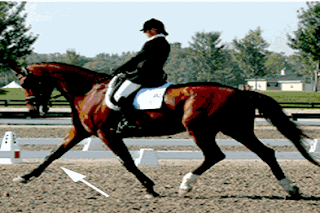Can a Horseshoe improve stride?
The following text is from an email I received concerning shod vs. barefoot.
Hi
I have an 11-year-old Lusitano stallion that is working towards Grand Prix dressage.
I have owned him since he was 3 years old and he has never had shoes on.
My farrier says he has the best feet of any horse he has ever seen. So far so good, but my dressage trainer, a Grand Prix rider from Holland, is insisting that I must put shoes on him.
He says that it will improve his front leg action making him lift his legs higher in movements like passage.
Is he right?
Wouldn't it only be a temporary reaction to the weight of the shoes?
The numerous downsides surely outweigh the possibility of more action.
I respect my trainer but I really don't want to put shoes on him, but my trainer can't understand why not.
I would love to hear any comments you might have please?
Kind regards
Rosie
From the UK
My response:
Dear Rosie,
Weight does have a huge effect on limb action, and yes, the weight of the shoe can alter gait. I have been a farrier for over three decades and in my earlier years, I worked on many Standardbred horses (Trotters and Pacers) using weight to alter or improve gait. Yes, I did say improve gait. I did not say improved biomechanics with the welfare of the horse in mind.
Seeing you have a healthy shoeless horse, I would not recommend shoeing this horse with a traditional rigid horse shoe, as the benefits of its weight does not outweigh the negative effects of the loss of foot function.
There are other means of achieving the goals your trainer has set. When we wanted to alter movement of the limb in the race horse (Trotter), we would use weights such as toe weights, side weights, or heel weights. A strategically placed 2 oz. weight would have adequate influence over foot flight, likely more so than a horseshoe placed balanced about the foots' axis. These hoof weights are available from several suppliers via the internet. Your trimmer should also be able to use their imagination to develop weights that would be less conspicuous on the hoof.
These weights should be applied to the lower outer hoof wall with glue, or screw, where desired. This type of weight is far less detrimental to foot function, but be advised, anytime you attempt to alter limb movement, you are creating strain that could lead to lameness. In addition to weights, there are horseshoes that offer needed elastic potential for better foot function, one such shoe is the titanium horseshoe.
In addition to weights, some trainers use weighted bell boots to help in developing muscle and muscle memory. Proper exercise, targeting the appropriate muscle groups goes a long way in releasing a horse's potential. See photos above.
I hope this information will be useful, pointing out that there are always alternatives to the traditional ridged shoe.
There are other means of achieving the goals your trainer has set. When we wanted to alter movement of the limb in the race horse (Trotter), we would use weights such as toe weights, side weights, or heel weights. A strategically placed 2 oz. weight would have adequate influence over foot flight, likely more so than a horseshoe placed balanced about the foots' axis. These hoof weights are available from several suppliers via the internet. Your trimmer should also be able to use their imagination to develop weights that would be less conspicuous on the hoof.
These weights should be applied to the lower outer hoof wall with glue, or screw, where desired. This type of weight is far less detrimental to foot function, but be advised, anytime you attempt to alter limb movement, you are creating strain that could lead to lameness. In addition to weights, there are horseshoes that offer needed elastic potential for better foot function, one such shoe is the titanium horseshoe.
In addition to weights, some trainers use weighted bell boots to help in developing muscle and muscle memory. Proper exercise, targeting the appropriate muscle groups goes a long way in releasing a horse's potential. See photos above.
I hope this information will be useful, pointing out that there are always alternatives to the traditional ridged shoe.
Keith "KC" La Pierre, MAEP, APR, RJF, CF, MIAEP

I'm sorry, I have to disagree with Rosie's so called Grand Prix instructor. He is short cutting at the expense of the horse's well being, artificially trying to reproduce HIS idea of how Rosie's horse should move. I've seen barefoot horses perform all the levels of Dressage better and happier than their shod competitors. Every movement within a dressage test is not gonna be a 10. Not every horse can do a passage well, but might do a piaffe exceptionally. You have to know your horse's natural abilities and focus on getting a high score on what they do well, knowing they may score lower on another movement. It's a balancing act. Dressage is a lifetime commitment to ATTEMPT perfection, which no one will achieve, but it sure is fun trying. In 45+ years of riding, I can tell you that I have had maybe 4-5 truly exceptional rides which I remember to this day. Soooo, trying to tie this all together, shoeing is NOT the solution.
ReplyDeleteYes, you are correct. Adding weights is NOT the solution
ReplyDelete